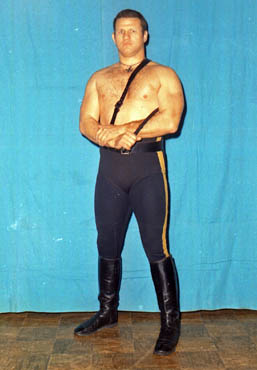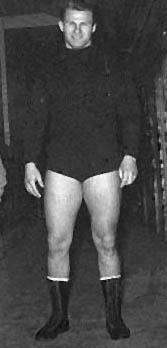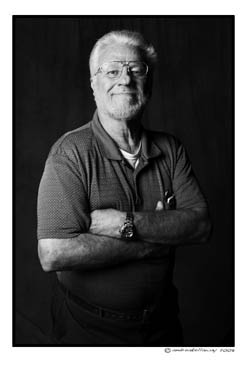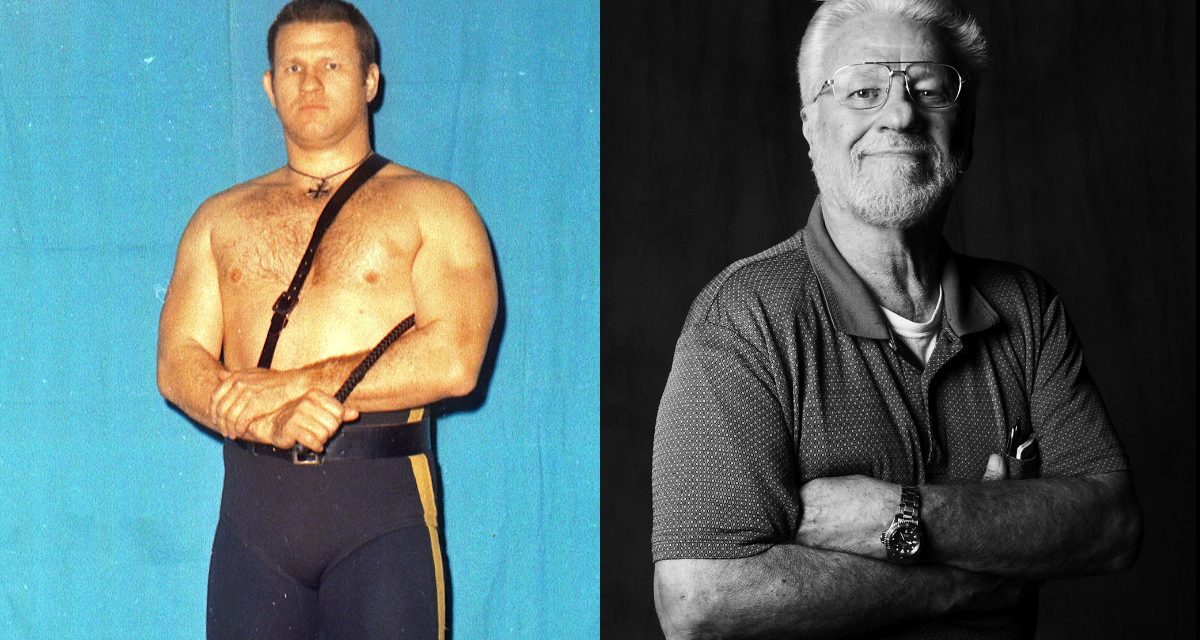Waldo von Erich, who died on Sunday at age 75, was always proud to be so hated. Here’s an oft-repeated story of his: “Vince McMahon, the father, he says to me one time, ‘You know, Waldo, I know what you’re like, but I hate your guts when you’re in that ring.'”
Or, as Ron Martinez said of von Erich’s role in his father’s NWF promotion, where the German was a top heel: “He made more money for us than anyone else. While not a great technical worker, his interviews were very strong for the time. People just hated him. He could P.O. the Pope. In particular, his programs against Ernie Ladd and Bruno [Sammartino] stand out as being very lucrative for us. [Dominic] Denucci as well. He was one of the true gentlemen in the sport.”

Waldo von Erich. Photo courtesy Chris Swisher
At 6-foot, 265 pounds, sporting a World War II helmet and whipping crop, von Erich portrayed the prototypical German, despite only being born in 1933 (in Toronto, Ontario) as the Nazis came to power. The gimmick was a natural for firing up the fans, he said. “I always had the heat. I never had any trouble getting huge heat with my gimmick. They always seemed to hate me.”
von Erich’s finishing move was the Blitzkreig, a kneedrop off the top rope, but Von Erich was never known for action. In the ring, frequent opponent Billy Red Lyons recalled Von Erich “didn’t do any more than he had to.” Von Erich didn’t disagree with the assessment. “I was very meticulous. You do too much and people don’t have time to grasp it. I liked to do things and let it sink it so they know what the hell you’re doing.
“It’s something that you have to see yourself, you either have it or you don’t. I never went out there and told people I would rip the guy’s arm off, or bury him, because they know that’s bullshit. I would just go out and say, [dropping into a low voice] ‘I enjoy twisting their arms, making them hurt and suffer.’ See, people grasp that. I never went out there and screamed and hollered or anything like that. It was just my style, and what I found that worked better.”
“Waldo wasn’t a tough guy, as far as going around — I don’t know if I ever remember him getting in a fight, or something like that,” said Bill Watts. “But he could emote such hatred. He had that Nazi snarl, he had stuff down. He could just turn people upside down. He totally had control of his interview. He was a great interview.”
von Erich loved to do the TV spots. “When I’d get on there for interviews, they’d be so godamn hot at me, you could hear a pin drop. Then the guys I’d be wrestling, they’d be in the room laughing like hell,” he boasted. “Some actors are good, and some aren’t. You have to feel it.”
Away from the ring, von Erich was really just Wally Sieber. He was quiet, and not a party guy. Backstage, he wasn’t especially close with any of the wrestlers, but was known for his sense of humour in the dressing room, cracking sly jokes.
“I don’t think that I ever saw him in a bad mood,” recalled Watts. “As a matter of fact, I think that if the people could have ever seen how funny and silly he was, he’d have never gotten over as a heel because he just had such an ongoing sense of humour, and his jokes were always just so damn silly.”
Heavily into weightlifting, Sieber trained in Toronto at the Weston YMCA and another gym along with other future pros like Baron Mikel Scicluna, Dave “Bearman” McKigney and Geto Mongol (Newt Tattrie).
“I first started with Red Garner. I was 16 when I started up there. We wrestled up in Richmond Hill, and they had a little small garage up there. Eddie Mangotich, Dubois was there with us,” recalled von Erich, adding that famous Canadian boxer George Chuvalo often was there working out as well.

Just plain Wally Sieber. Terry Dart Collection
It was his trainer, Red Garner, who influenced the 16-year-old the most, including in evil ways. A German heel almost from the get-go, Waldo Von Seiber (or sometimes Baron Von Seiber) used to have long, blond hair, and wore monocle — and had his own wrestling brother, Kurt Von Seiber.
It wasn’t long before Sieber realized there was a glass ceiling in Toronto, and that local talent didn’t have much of a chance to outshine the local hero, Whipper Billy Watson — unless they were willing to sell out.
“They wanted me to take his place, you know that,” von Erich once explained. “They wanted me to take over his place, but they wanted 50 per cent. I said, ‘I don’t need you that bad.’
“I knew what my potential was, and so did they. If they had asked for less, I might have gone. But not for 50 per cent, shit, not for being tied up that long.”
In Jack Adkisson, Sieber found a true mentor. Adkisson, who wrestled as Fritz von Erich, was four years older and that much more experienced. “I wrestled a few places around Toronto, and Fritz liked me. I met him out in Minneapolis. That’s where we started out as a tag team, the Von Erich brothers,” he said. “When you’re in with top guys right from the beginning, you learn pretty quick.”
There was a definite contrast between the Von Erich brothers. “He was smoother. … he was smaller too, he wasn’t as a big as Fritz,” said Lyons. Historian Fred Hornby said they made a good team. “I think Wally Seiber knew a hell of a lot more basic holds, he knew a hell of a lot more about wrestling than Fritz did,” Hornby said.
Over the years, Waldo von Erich would form other formidable tag teams with the likes of Gene Kiniski, The Spoiler (Don Jardine) and Karl Von Brauner (Doug Donovan).
As a singles competitor, Waldo Von Erich was on top just about everywhere he wrestled. He’s perhaps best known for a series of battles with Bruno Sammartino around the WWWF: In 1964, they headlined Madison Square Garden three times, including an epic 81-minute draw in August; in 1969; and again in 1975, when Waldo was victorious in one bout as the match was stopped because of excessive bleeding, with 24,553 patrons at MSG, including the adjacent Felt Forum.
As a key figure in the NWF, which ran in the Buffalo to Cleveland area, von Erich took the NWF World title from Johnny Powers in November 1971, losing it a month later to Dominic Denucci. He then beating Denucci to start a second reign on January 5, 1972, holding on to the title until June, when he fell to Ernie Ladd.
Denucci said that von Erich was “naturally bad” and “the people didn’t like him. Waldo was a good wrestler.” The man von Erich once called a “spaghetti bender” on TV said they had good matches. “I made some money when I wrestled him.”
There were a few times that von Erich worked under a mask as well. In Indianapolis, around 1962, he worked as Mr. M, unmasking after a loss to Bill Melby. The following year, he was The Great Zimm in Vancouver.
There was El Tigre, under a leopard skin mask. According to von Erich, Zimm came about because the commission had a rule that if you bled, you were suspended for 30 days, and you had to go back to the commissioner to get reinstated. “I wore a hood for a while until after 30 days. It was a stupid thing,” he said. “I was suspended there for a while, until I got back my license.” (He also told the same story about the El Tigre mask in our Q&A session.)
Looking back at his career, von Erich was never modest. “I’m not blowing my own horn, but I guess I was the hottest heel in each territory I was in,” he said, often taking credit for perhaps far more than called for.
He “got almost everything” he wanted from pro wrestling, including fancy cars, and world-wide fame. He even owned a lake in Northern Ontario for a while, and had property in Belize.
His fascination with old cars was something that the other wrestlers remembered.
“I always loved old cars, I always had old cars. The first car I had, I was 16 years old, a 1945 Passenger Cadillac limousine. There were only two in Canada,” von Erich said. In recent years, he had a customized Porsche 928S and a 60-year-old Rolls Royce.
Upon hearing the name Waldo von Erich, Sandy Scott launched into an old story. “He loved these old cars. He used to go around and look for these old cars. I went down to Atlanta, and he was down there. He bought this old car. It was one of the old German cars that the guys used to drive the generals in. I said, ‘Oh, what are you going to do?’ He said, ‘I’m going to drive it home. I’m going to leave after the match and drive it home.’ He was on early, and we were on last. We got in the car and away we went. Well, to my surprise, I come up on this guy doing 35-40 miles an hour. I said, ‘Look at that thing.’ We went by and it’s Waldo. I said, ‘Good God, he’s not going to get back until tomorrow afternoon!'”
von Erich disputed Scott’s recollections. The car was fast, but he didn’t know how to use it at that point. “It had gauges to tell you what the other gauges were doing. When I first got the car, I didn’t know how to open up the door from the inside because the doors would automatically lock.”

Waldo von Erich strikes a pose in 2008. Photo by Andrea Kellaway
In 1973, Sieber first tried to retire from professional wrestling, but stuck around until 1979. He got a certificate of Reflexology and worked as a physical therapist in Kitchener, Ontario. Sieber also was an inventor, creating an inverted chair to help with back problems. “I got endorsements from Lee Trevino, the Boston Bruins, Toronto Blue Jays, the Department of National Defense bought six of them. But they were very expensive,” he said. “My friend and I used to go to these chiropractic conventions every year. The young chiropractors used to be there early in the morning, waiting for treatments for their hangovers. So one time Chris asked one of them, ‘Why don’t you guys buy more chairs?’ You know what they said? ‘They work too good.'”
In the late 1990s, Sieber got involved with a wrestling school in Cambridge, Ontario, run by Joe Frocklidge (who wrestled very briefly as Ike Shaw). There, Sieber had a hand in training the likes of Eric Young, The Highlanders, and Eddie Osbourne.
von Erich lived in Elmira, Ontario, since 1972, minus a stint a few years ago living with a girlfriend in Brampton. He was married just once — “that’s enough” he once quipped — to Betty, with whom he had three daughters.
The funeral for Wally Sieber will be on Monday, July 13, at Dreisinger Funeral Home, 62 Arthur Street South, Elmira, ON, 519-669-2207. Visitation will be one hour prior to the 11 a.m. service.
WALDO VON ERICH HEADLINING AT MADISON SQUARE GARDEN
August 22, 1964, drew with Sammartino (81:00), Att: 16,958
September 21, 1964, lost by countout to Sammartino (34:25), Att: 14,915
October 19, 1964, lost to Sammartino (14:57), Att: 18,722
October 1, 1969, beat Sammartino by DQ
October 27, 1969, lost to Sammartino (16:54), ATT: 11,128
May 19, 1975, beat Sammartino (21:19, match stopped, blood), Att: 24,553, incl. Felt Forum
June 16, 1975, lost to Sammartino (4:12)
RELATED LINKS
- July 13, 2009: A final goodbye to Waldo von Erich
- July 6, 2009: Waldo von Erich dies suddenly
- July 6, 2009: The fans share Waldo von Erich memories
- March 18, 2009: Waldo von Erich Q&A: Part 2
- March 11, 2009: Waldo von Erich Q&A: Part 1
Greg Oliver has a signed Titans in Toronto III poster in his office, signed by Waldo von Erich. Rest in peace, Uncle Waldo. Greg can be emailed at goliver845@gmail.com.

